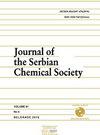与(2-吡啶基甲基)氨基衍生物的方锥体单核、双核和聚合铜(II)配合物
IF 1
4区 化学
Q4 CHEMISTRY, MULTIDISCIPLINARY
引用次数: 0
摘要
3种配体前体2-[(2-吡啶基甲基)氨基]醋酸盐酸盐、4-[(2-吡啶基甲基)氨基]苯甲酸盐酸盐和4-{[2-(吡啶-2-基甲基氨基)乙胺]甲基}苯甲酸盐酸盐的配位行为盐酸- HL3 ?分别描述了HCl在铜(II)配合物中的作用。通过元素分析、ESI质谱、红外光谱以及x射线结构分析对配合物进行了表征。铜(II)与HL1的反应?HCl在甲醇中形成聚合物配合物[{Cu(?- cl)2(MeL1- ?2N,N?)} N](1),其特征是L1 (MeL1)的甲酯。HL2吗?HCl还是HL3?得到了二聚体配合物[{CuCl(- cl)(HL2- - 2N,N?)}2](2)或单核配合物[CuCl2(HL3- - 3N,N?,N?)](3)。所有的复合体都呈现出方-锥体几何形状。在1中,聚合物链是通过桥接氯基配体形成的,没有典型的氢键相互作用。相反,2中的COOH基团参与分子间氢键的形成,形成超分子结构。在3中,分子间氢键(Cl?O)形成一维聚合物结构。铜(II)复合物2降低了人类8505C、MCF-7、518A2和SW480细胞系的活力。2的杀瘤作用主要通过caspase介导的细胞凋亡实现。本文章由计算机程序翻译,如有差异,请以英文原文为准。
Square-pyramidal mononuclear, dinuclear and polymeric copper(II) complexes with (2-pyridinylmethyl)amino derivatives
The coordination behavior of three ligand precursors 2-[(2- pyridinylmethyl)amino]acetic acid hydrochloride, 4-[(2- pyridinylmethyl)amino]benzoic acid hydrochloride and 4-{[2-(pyridin-2- ylmethylamino)ethylamino]methyl}benzoic acid hydrochloride, HL1?HCl- HL3?HCl, respectively, in copper(II) complexes is described. The complexes were characterized by elemental analysis, ESI mass spectrometry and IR spectroscopy, as well as X-ray structural analysis. The reaction of copper(II) with HL1?HCl in methanol afforded the polymeric complex [{Cu(?-Cl)2(MeL1- ?2N,N?)}n] (1) featuring the methyl ester of L1 (MeL1). With HL2?HCl or HL3?HCl, the dimeric complex [{CuCl(?-Cl)(HL2-?2N,N?)}2] (2) or the mononuclear complex [CuCl2(HL3-?3N,N?,N??)] (3) were obtained. All complexes exhibited square-pyramidal geometries. In 1, polymeric chains are formed through bridging chlorido ligands without typical hydrogen bonding interaction. Contrarily, the COOH group in 2 is participating in the formation of intermolecular hydrogen bonding forming a supramolecular structure. In 3, intermolecular hydrogen bonding (Cl?O) leads to a 1-D polymeric structure. The copper(II) complex 2 diminished viability of human 8505C, MCF-7, 518A2 and SW480 cell lines. The tumoricidal effect of 2 was realized mainly through caspase-mediated apoptosis.
求助全文
通过发布文献求助,成功后即可免费获取论文全文。
去求助
来源期刊
CiteScore
1.80
自引率
0.00%
发文量
76
审稿时长
1 months
期刊介绍:
The Journal of the Serbian Chemical Society -JSCS (formerly Glasnik Hemijskog društva Beograd) publishes articles original papers that have not been published previously, from the fields of fundamental and applied chemistry:
Theoretical Chemistry, Organic Chemistry, Biochemistry and Biotechnology, Food Chemistry, Technology and Engineering, Inorganic Chemistry, Polymers, Analytical Chemistry, Physical Chemistry, Spectroscopy, Electrochemistry, Thermodynamics, Chemical Engineering, Textile Engineering, Materials, Ceramics, Metallurgy, Geochemistry, Environmental Chemistry, History of and Education in Chemistry.

 求助内容:
求助内容: 应助结果提醒方式:
应助结果提醒方式:


